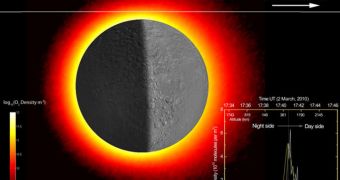Using data collected by the NASA Cassini spacecraft during a March flyby, experts were able to conclude that the Saturnine moon Rhea, the second-largest orbiting the gas giant, is surrounded by a carbon and oxygen-rich atmosphere.
The wispy layer could only be identified after the probe swept very close to the body's surface, at an altitude of 60 miles (97 kilometers) above the north polar regions.
Past flights that were conducted in 2005 and 2007 provided astronomers with hints that something interesting was going on in the moon's atmosphere, but the spacecraft could not provide any clear evidence on account of the distance the flybys were carried out.
Those instances took Cassini some 312 miles (502 kilometers) and 3,564 miles (5,736 kilometers) above the surface, which was far enough to skew the results its instruments produced.
But this did not happen in March. As such, the orbiter was able to identify two of the most important chemicals for life in Rhea's atmosphere, the first time this happened on a moon around Saturn.
Oxygen-rich atmospheres are generally hard to come by in our solar system. Earth has one, and two others can be found surrounding the Jovian moons Europa and Ganymede.
The new investigation shows that this type of atmosphere can develop around more types of celestial bodies than initially thought. Ice-covered natural satellites can therefore be considered as potential sources of rich and complex chemistry.
“We've seen this happening at Jupiter, and now we've confirmed it on a Saturn moon. The fact that it's widespread is very exciting,” says Ben Teolis, the lead author of a paper detailing the findings in the November 25 issue of the top journal Science.
Teolis holds an appointment at the San Antonio, Texas-based Southwest Research Institute (SwRI).
He says that the new Cassini findings could inform experts to scan the Saturnine system more thoroughly. It contains a lot of big, frozen moons, some or all of which may have enough gravitational pull to keep an atmosphere around them.
Rhea, for example, has a diameter of 950 miles (1,529 kilometers), which makes it massive enough to hold on to an atmosphere. The NASA orbiter found important amounts of oxygen and carbon dioxide in the air around the frozen moon.
Spectrometers aboard Cassini determined that more than 70 percent of the atmosphere is made up of O2, while some 30 percent contains CO2. But the air as a whole is a lot thinner than that around Jupiter's Europa, for example.
This is the main reason why the probe was unable to use its instruments to detect the chemicals from farther away, Space reports.

 14 DAY TRIAL //
14 DAY TRIAL //